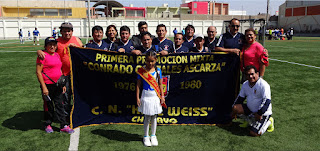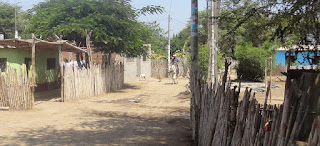We were on a combi about half-way between San Antonio where
we had visited earlier in the day and Chiclayo, both of us lost in thought when Maribel
suddenly looked at me and asked, ”What are you going to write about San
Antonio?” When I looked at her quizzically she continued with, “What I mean is,
how many ways are there to say that a poor, small desert village has an under-equipped
pronoei that needs tables, chairs, storage shelves and a whiteboard?” Hmmm.
Often when we’ve visited a village that we hope to help I am
able to mentally compose a post on the combi, so that when we get home all I
have to do is sit down and start writing. Sometimes not. Sometimes there is a
complete blank when I sit down at the computer, and I need a couple of days to
compose something that is hopefully interesting. I was concerned that Maribel’s
question to me would result in a month’s worth of writer’s block, but then I
thought, look, I was there, I saw things and I talked with people. I formed
impressions about some of the things I saw and heard. Why not just sit down and
start writing about those impressions? So here we go.
San Antonio is a small desert village. You already know
that. What you don’t know is that the village and a large portion of the entire
area is surrounded by dry rice paddies with brown rice plants wanting to be
harvested now. That means the processing factories in the city of Lambayeque
will be gearing up to process that rice, which means field workers, truck drivers
and factory workers will have steady work for a while. There are 28 regions in
Peru. The Lambayeque Region produces the majority of rice grown in Peru, with
some estimates being as high as 80%.

San Antonio is located smack on the bank of the Chancay
River. Until today we had never seen a village in the Lambayeque Valley located
on a river bank because of the danger of seasonal flooding. The difference here
is that the Chancay River has been harnessed. There are concrete sides and bottom
to contain it, and sluice gates to control it. The irrigation provided by the
river is the reason for the abundance of rice, corn and sweet potatoes.

This is the exterior of the pronoei Gotitas de Ternura (Droplets
of Tenderness). That’s Purgatory Mountain in the background. The mountain is visible
from most of the villages in the eastern half of the Tùcume district. On and around
the mountain are ruins of temples and pyramids from the Moche culture, dating
from about 600 AD to 1200 AD. There are still some people in the area who believe the
mountain harbors spirits. Among the ruins is a small but attractive and
informative site museum. A man working at the museum owns the house the pronoei
occupies. He has said the pronoei can continue in the house for the foreseeable
future.
Maria Del Rosario Veliz has taught at Gotitas de Ternura for
the past two years. Prior to that she taught at a pronoei in the village of
Zapotal. Maria has 12 students, some with given names I had never heard before,
like Milagros (Miracle), Kard and Sayaka. They are happy kids and were eager to
show us the coloring they were doing when we arrived.
Maria didn’t ask for school supplies, uniforms or a
whiteboard. She would like 2 tables and 12 chairs, saying that the plastic
chairs she has are borrowed from village families. The cost would be:
2 tables @ $36/ea - $72
12 chairs @ $13.75/ea - $165
2 storage shelves @ $24/ea - $48
Transport and Misc. – $25
Total - $310
Please
help us with this project by visiting the Promesa
Peru webpage. A donation of just $13.75 will provide one of those kids with a safe and sturdy chair. Thank you.












